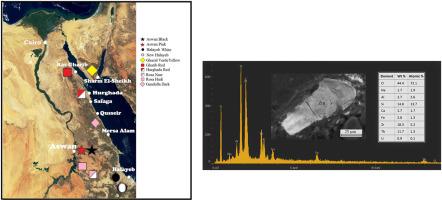埃及商业品牌观赏花岗石的安全规范及辐射危害评估
IF 1.8
3区 工程技术
Q3 CHEMISTRY, INORGANIC & NUCLEAR
引用次数: 0
摘要
伽马射线光谱分析用于测量和评估当地使用和出口的商业品牌埃及花岗岩的自然辐射的潜在危害。Halayeb花岗岩品种eU/eTh比值≥1,Gandolla和Hurgada红花岗岩品种eU/eTh比值在0.5-1之间。这些品种的eU和eTh含量均低于上大陆地壳(UCC)的平均值。eU/eTh比率为0.5。含铀样品除富集铀外,还显著富集钍和放射性成因钾(40K)。Kasolite是Ghazal Verde唯一发现的次生铀矿物,是唯一的碱花岗岩品种。放射性核素存在于一些辅助矿物中,如褐褐矿、独居石和柱长石。铌石含有2.6 wt% U (Ghazal Verde黄)。赫尔格达红花岗岩含富铀、富钍锆石,铀含量为0.9 wt%,钍含量为11.7 wt%。建议使用安全代码/等级(从1,非常安全到5,非常危险),其中非常安全的商业品种是阿斯旺黑色和粉红色,Halayeb白色,新Halayeb和Gharib红色。为了避免辐射危害,这些商业品牌的eU、eTh、RaeU和40K的活性浓度(分别高达~ 236、106、122和2066 Bq kg - 1)应在建筑项目的外部或内部设计中进行任何应用之前进行考虑。本文章由计算机程序翻译,如有差异,请以英文原文为准。

Towards a safety code and assessment of radiation hazards in commercial brands of ornamental granites from Egypt
Gamma-ray spectrometric analysis is used to measure and assess potential hazards of natural radiation in commercial brands of Egyptian granite used locally and for export. Ratio of eU/eTh of the Halayeb granite varieties amounts ≥1 whereas this ratio lies in the range of 0.5–1 for Gandolla and Hurgada red. Contents of eU and eTh in these varieties are below the average in the upper continental crust (UCC). The eU/eTh ratio amounts <0.5. In addition to enrichment of U in the uraniferous samples, they are noticeably enriched in Th and radiogenic potassium (40K). Kasolite is the only secondary U mineral found in Ghazal Verde, which is the sole alkali granite variety. Radionuclides are present in several accessory minerals such as allanite, monazite and columbite. Columbite contains 2.6 wt% U (Ghazal Verde yellow). Hurghada red granite contains U- and Th-rich zircon with 0.9 wt% U and 11.7 wt% Th. A safety code/scale (from 1, very safe to 5, very hazardous) is suggested in which the very safe commercial varieties are Aswan black and pink, Halayeb white, New Halayeb and Gharib red. To avoid radiation hazards, activity concentration of eU, eTh, RaeU and 40K (up to ∼236, 106, 122 and 2066 Bq kg−1, respectively) in these commercial brands should be considered prior to any application in construction projects either for exterior or internal designs.
求助全文
通过发布文献求助,成功后即可免费获取论文全文。
去求助
来源期刊

Applied Radiation and Isotopes
工程技术-核科学技术
CiteScore
3.00
自引率
12.50%
发文量
406
审稿时长
13.5 months
期刊介绍:
Applied Radiation and Isotopes provides a high quality medium for the publication of substantial, original and scientific and technological papers on the development and peaceful application of nuclear, radiation and radionuclide techniques in chemistry, physics, biochemistry, biology, medicine, security, engineering and in the earth, planetary and environmental sciences, all including dosimetry. Nuclear techniques are defined in the broadest sense and both experimental and theoretical papers are welcome. They include the development and use of α- and β-particles, X-rays and γ-rays, neutrons and other nuclear particles and radiations from all sources, including radionuclides, synchrotron sources, cyclotrons and reactors and from the natural environment.
The journal aims to publish papers with significance to an international audience, containing substantial novelty and scientific impact. The Editors reserve the rights to reject, with or without external review, papers that do not meet these criteria.
Papers dealing with radiation processing, i.e., where radiation is used to bring about a biological, chemical or physical change in a material, should be directed to our sister journal Radiation Physics and Chemistry.
 求助内容:
求助内容: 应助结果提醒方式:
应助结果提醒方式:


